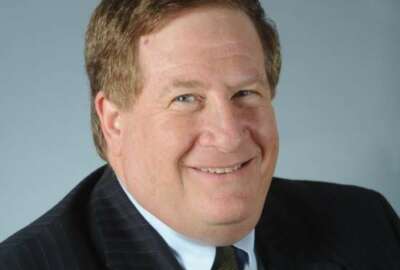
A new program for those looking to learn the ins and outs of defense contracting
The University of Oklahoma's Graduate School of Business has launched an online graduate degree program for aerospace and defense.
Best listening experience is on Chrome, Firefox or Safari. Subscribe to Federal Drive’s daily audio interviews on Apple Podcasts or PodcastOne.
Defense contracting is a multi-hundred-billion dollar activity. It can also be highly technical and demanding. Now the University of Oklahoma’s Graduate School of Business has launched an online graduate degree program for aerospace and defense. Joining me with the details, the program director, Shad Satterthwaite.
Interview transcript:
Tom Temin: Mr. Satterthwaite, good to have you on.
Shad Satterthwaite: Good to be on, Tom. Thank you.
Tom Temin: So what is the motivation for launching a program like this at this particular time?
Shad Satterthwaite: Yeah, that’s a good question. Oklahoma is an energy state but our second largest economic sector is aerospace and defense. And the University of Oklahoma in Norman is just south of Oklahoma City. And Tinker Air Force Base is right here in the center. And so Oklahoma is really a hub in many ways for the aerospace and defense industry. It’s very important for us politically, our Sen. [Jim] Inhofe chairs the Senate Armed Services Committee, and NASA Administrator Jim Bridenstine was a former member of Congress from Oklahoma. So it’s a very important industry for our state. Because we’re close to Tinker Air Force Base there have been a number of defense contractors that have located here. And there is a need, as this sector grows in Oklahoma, to have an educated workforce in aerospace and defense, a lot of those are engineer positions. But the Business College was approached by the industry saying, “Hey, we need management training for this sector. And so they stepped up and put together this program where you can get an executive MBA in a year’s time for those that are working in the industry right now. It’s kind of a hybrid, mostly online. There are three residency weeks here too. But that was the impetus behind getting this started.
Tom Temin: And what are the unique managerial challenges in defense and aerospace say that you might not find in, you know, chocolate making or automobile building?
Shad Satterthwaite: That’s true. That’s true. You know, and I’ve been asked that before what why not just a standard MBA? You know, could it be applicable here to aerospace and defense? The answer is what they’re finding – it’s a highly technical industry. And we, even in the state of Oklahoma want to recruit more engineers to this field. But there’s a need to bridge the gap between the vision that our defense contractors have and what the government needs them to produce, and then the actual production of it. And so you’ve got a lot of bright people that are very tech savvy, very talented, and yet they need training to manage that to be able to share that vision to talk that talk, as well as talk with the engineers are talking about and be able to relay that both up and down in the production lines.
Tom Temin: And I guess over the decades, companies that have both military aerospace contracting businesses and commercial have struggled, really, with trying to combine them into one company, unless you’re maybe like a General Electric where the engines are essentially the same whether for a commercial aircraft or a defense aircraft.
Shad Satterthwaite: Yeah, you make you make a very good point there, because they are different. There’s a lot of different pieces there. And translating that into something where you can be able to relate that with the needs are of the government with the industry can provide. And then getting back to where that’s produced. You know that the single largest customer in aerospace and defense is the U.S. government. And so we do feel that’s an important piece of this program is teaching those that will be in the class, how the government process works, the contracting process works in those kinds of things.
Tom Temin: We’re speaking with Shad Satterthwaite. He’s director of the executive business programs in aerospace and defense at the University of Oklahoma. And what types of people do you wish to attract to this program? Engineers that want to get on to the business side perhaps, or mid-level executives in the business end already, or what?
Shad Satterthwaite: Yeah, what we’re seeing as prospective students are inquiring about the program – they come from three areas, primarily. One is military personnel that are transitioning out of the service and want to start another career in defense and aerospace on the civilian side. The other is with, as you mentioned, engineers, aerospace engineers in particular that have management aspirations. And then the other, the third part are those that are in leadership or managerial positions already, that just want to get an added credential and learn even more so that they can apply those skill sets more fully to their organizations.
Tom Temin: And what about people that might be in government say, as contracting officers or program managers in some of these areas? Would they benefit and are they eligible?
Shad Satterthwaite: Yeah, they certainly would. In fact, we would like to attract more of those there. And I think right now the program is so new in our marketing efforts. That is a sector that we haven’t marketed to as much as we could have, as the program develops, our first cohort is going to be starting this August. We hope to have more in there because, as you mentioned, Tom, we think this program can be very valuable to someone in that position.
Tom Temin: And what are some of the business, I guess, understandings that maybe aerospace executives or would-be executives would need to have? I can think of one for example, is that the sales cycles and the payment and accounting processes can be very different, when you have a federal customer versus a commercial customer.
Shad Satterthwaite: It is. I’ll tell you about some of the courses that you take in that and sales is certainly one of those. One of our faculty members is – he started his own company, you know, because he was very good at government contracts. He’s a lawyer by trade, and he is going to be teaching the government contracts course. And he started up his own company here in Oklahoma City, and is very excited about this particular program, because just as you’re pointing out, he thinks it’s very important to understand how that process works. And so we have a number of different courses – managing government contracts is one of those courses. But also, you mentioned the sales, marketing. There are specific rules and regulations that need to be understood for that. Mergers and acquisitions, global aerospace and defense strategy and that’s a particularly neat class because that’s going to be done overseas. And so it’s an executive program that’s mostly online. But we do have three resident modules throughout the course of the year at the beginning, in the middle and at the end, and the one in the middle is going to be in Europe. So we’re going to be doing some field trips there to some different sites to give the students a better idea of what the global and aerospace defense strategy is – kind of a bird’s eye view, if you will.
Tom Temin: It sounds like a good opportunity for participants to meet people in the cohort and maybe form relationships that could take them through their industrial careers.
Shad Satterthwaite: Oh, you bet it is. That’s really the whole point of the class, the executive education, doing it in the format that we are. It’s a cohort model. So students will come together. We’ll bring ’em in that first week here in Oklahoma City. They’ll work together for a week with a broad range of backgrounds and perspectives, they get to know each other, they get to establish those relationships. Then they go back to their places of work and do the online training ’til they meet again, to go to Europe. More online training after the European resident phase. And then the very end they’ll meet back up in Oklahoma City. And so yes, they are networking, but you know, also creating lifelong friendships and connections through this cohort model.
Tom Temin: And what is your own background that led you to this particular perch at Oklahoma?
Shad Satterthwaite: Yeah, so I’ve been on faculty at the University of Oklahoma since 1998. And then I’ve had different administrative positions. My last position prior to this one was I was the associate dean for extended campus. And we have programs at the University of Oklahoma on military bases in North America and and Europe as well as online courses. And so I’m also the faculty adviser for our Student Veterans Association. So I have a background in the military. I’m currently a colonel in the Army Reserves. And I just had – this is a very interesting sector for me, obviously. And so being able to marry my academic interest with my interest in the military and government just seemed like a great fit when I moved over to the College of Business. So it’s something I’m obviously very excited to do.
Tom Temin: And the first cohort begins when?
Shad Satterthwaite: Aug. 16.
Tom Temin: All right, well, good luck.
Shad Satterthwaite: Thank you, Tom.
Tom Temin: Shad Satterthwaite is director of the executive business programs in aerospace and defense at the University of Oklahoma. Thanks so much for joining me.
Shad Satterthwaite: My pleasure, Tom, it’s great being with you today.
Tom Temin: We’ll post this interview along with a link to more information at FederalNewsNetwork.com/FederalDrive. Hear the Federal Drive on your schedule. Subscribe at Apple Podcasts or Podcastone.
Copyright © 2025 Federal News Network. All rights reserved. This website is not intended for users located within the European Economic Area.
Tom Temin is host of the Federal Drive and has been providing insight on federal technology and management issues for more than 30 years.
Follow @tteminWFED
Related Stories

New rules for defense contractors adding up this week




